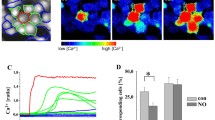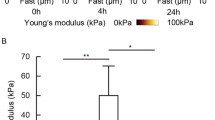Abstract
The smooth muscle cell is the predominant cell type of the arterial media. In the adult vascular system, smooth muscle cells are found primarily in the contractile phenotype, but following injury or during atherosclerotic plaque formation the secretory synthetic phenotype is expressed. Recently it has been shown that gap junction connexin43 messenger RNA levels are six times higher in cultured smooth muscle cells in the synthetic phenotype than in intact aorta. We have modulated rabbit aortic smooth muscle cells in culture between the synthetic phenotype and one resembling the contractile phenotype, and correlated gap junction expression with phenotype. A dual labelling technique with antibodies against smooth muscle myosin and a synthetic peptide constructed to match a portion of the connexin43 gap junction protein was used for these experiments. Gap junctions are numerous between synthetic phenotype cells but few are observed between contractile cells. Rat aortic smooth muscle cells were also cultured and the growth and structure of gap junctions followed in the synthetic phenotype by use of freeze-fracture electron microscopy and immunohistochemical techniques. Junctional plaques are similar in structure to those observed in cardiac muscle, their size and number increasing with time in culture. The increased numbers of gap junctions between synthetic phenotype smooth muscle cells may be important during vessel development, following injury, or in atherosclerotic plaque formation.
Similar content being viewed by others
References
Beyer EC, Paul DL, Goodenough DA (1987) Connexin43: a protein from rat heart homologous to a gap junction protein from liver. J Cell Biol 105:2621–2629
Beyer EC, Paul DL, Goodenough DA (1990) Connexin family of gap junction proteins. J Membr Biol 116:187–194
Burnstock G (1975) Innervation of vascular smooth muscle: histochemistry and electron microscopy. Clin Exp Pharmacol Physiol Suppl 2:7–20
Burghardt RC, Matheson RL (1982) Gap junction amplification in rat ovarian granulosa cells. Devel Biol 94:206–215
Campbell GR, Campbell JH (1985) Smooth muscle phenotypic changes in arterial wall homeostasis: Implications for the pathogenesis of atherosclerosis. Exp Mol Pathol 42:139–162
Campbell GR, Chamley-Campbell JH, Burnstock G (1981) Differentiation and phenotypic modulation of arterial smooth muscle. In: Schwartz CJ, Werthessen NT, Wolf S (eds) Structure and Function of Circulation, vol 3. Plenum Press, New York, pp 357–399
Campbell GR, Campbell JH, Manderson J, Horrigan S, Rennick RE (1988) Arterial smooth muscle — A multi functional mesenchymal cell. Arch Pathol Lab Med 112:977–986
Chamley-Campbell JH, Campbell GR (1981) What controls smooth muscle phenotype? Atherosclerosis 40:347–357
Dermietzel R, Yancey SB, Traub O, Willecke K, Revel J-P (1987) Major loss of the 28-kd protein of gap junction in proliferating hepatocytes. J Cell Biol 105:1925–1934
Fishman JA, Ryan GB, Karnovsky MJ (1975) Endothelial regeneration in the rat carotid artery and the significance of endothelial denudation in the pathogenesis of myointimal thickening. Lab Invest 32:339–351
Flagg-Newton JL, Loewenstein WR (1981) Cell junction and cyclic AMP: II Modulation of junctional membrane permeability is dependent on serum and cell density. J Membr Biol 63:123–131
Fraser SE, Green CR, Bode HR, Gilula NB (1987) Selective disruption of gap junctional communication interferes with a patterning process in Hydra. Science 237:49–55
Garfield RE, Sims SM, Daniel EE (1977) Gap junctions: their presence and necessity in activation of the myometrium at parturition. Science 198:958–959
Gilula NB, Reeves OR, Steinbach AD (1972) Metabolic coupling, ionic coupling and cell contacts. Nature 235:262–265
Gourdie RG, Green CR, Severs NJ (1991) Gap junction distribution in adult mammalian myocardium revealed by an anti-peptide antibody and laser scanning confocal microscopy. J Cell Sci 99:41–55
Green CR, Severs NJ (1984) Gap junction connexon distribution in rapidly frozen myocardium and isolated intercalated disks. J Cell Biol 99:453–463
Harfst E, Severs NJ, Green CR (1990) Cardiac myocyte gap junctions: evidence for a major connexon protein with an apparent relative molecular mass of 70 000. J Cell Sci 96:591–604
Karrer HE (1961) An electron microscope study of the aorta in young and aging mice. J Ultrastruct Res 5:1–27
Lash JA, Critser ES, Pressler ML (1990) Cloning of a gap junctional protein from vascular smooth muscle and expression in two-cell mouse embryos. J Biol Chem 265:13113–13117
Loewenstein W (1979) Junctional intercellular communication and the control of growth. Biochem Biophys Acta 560:1–65
Mehta PP, Bertram JS, Loewenstein WR (1986) Growth inhibition of transformed cells correlates with their junctional communication with normal cells. Cell 44:187–196
Mehta PP, Bertram JS, Loewenstein WR (1989) The actions of retinoids on cellular growth correlate with their actions on gap junctional communication. J Cell Biol 108:1053–1065
Meyer R, Malewicz B, Baumann WJ, Johnson RG (1990) Increased gap junction assembly between cultured cells upon cholesterol supplementation. J Cell Sci 96:231–238
Milks LC, Kumar NM, Houghten R, Unwin N, Gilula NB (1988) Topology of the 32 kd liver gap junction protein determined by site-directed antibody localizations. EMBO J 7:2967–2975
Moore LK, Beyer EC, Burt JM (1991) Characterization of gap junction channels in A7r5 vascular smooth muscle cells. Am J Physiol 260:C975-C981
Paule WJ (1963) Electron microscopy of the newborn rat aorta. J Ultrastruct Res 3:469–483
Pauli BV, Weinstein RS, Soble LW, Alroy J (1977) Freeze-fracture of monolayer cultures. J Cell Biol 72:763–769
Pease DC, Paule WJ (1960) Electron microscopy of elastic arteries. The thoracic aorta of the rat. J Ultrastruct Res 3:469–483
Pepper MS, Spray DC, Chanson M, Montesano R, Orci L, Meda P (1989) Junctional communication is induced in migrating capillary endothelial cells. J Cell Biol 109:3027–3038
Rennick RE, Campbell JH, Campbell GR (1988) Vascular smooth muscle cell phenotype and growth behaviour can be influenced by macrophages in vitro. Atherosclerosis 71:35–43
Risek B, Guthrie S, Kumar N, Gilular NB (1990) Modulation of gap junction transcript and protein expression during pregnancy in the rat. J Cell Biol 110:269–282
Ross R (1986) The pathogenesis of athroschlersosis — an update. N Engl J Med 314:488–500
Schwartz SM, Stemerman MB, Benditt EP (1975) The aortic intima. II. Repair of the aortic lining after mechanical denudation. Am J Pathol 81:15–42
Segal SS, Duling BR (1986) Flow control among microvessels coordinated by intercellular conduction. Science 234:868–870
Segal SS, Duling BR (1989) Conduction of vasomotor responses in arterioles: a role for cell-to-cell coupling? Am J Physiol 256:H838-H845
Severs NJ (1989) Constituent cells of the heart and isolated cell models in cardiovascular research. In: Piper HM, Isenberg G (eds) Isolated Adult Cardiomyocytes. CRC Press, Boca Raton, pp 3–41
Severs NJ (1990) The cardiac gap junction and intercalated disk. Int J Cardiol 26:137–173
Sosa-Melgarejo JA, Berry CL (1989) Contact relationships between vascular smooth muscle cells: An in vivo and in vitro study. J Pathol 157:213–217
Warner AE, Guthrie SC, Gilula NB (1984) Antibodies to gap-junctional protein selectively disrupt junctional communication in the early amphibian embryo. Nature 311:127–131
Wissler RW (1968) The arterial medial cell, smooth muscle of multifunctional mesenchyme? J Atherosclerosis Res 8:201–213
Zimmer DB, Green CR, Evans WH, Gilula NB (1987) Topological analysis of the major protein in isolated intact rat liver gap junctions and gap junction-derived single membrane structures. J Biol Chem 262:7751–7763
Author information
Authors and Affiliations
Rights and permissions
About this article
Cite this article
Rennick, R.E., Connat, J.L., Burnstock, G. et al. Expression of connexin43 gap functions between cultured vascular smooth muscle cells is dependent upon phenotype. Cell Tissue Res 271, 323–332 (1993). https://doi.org/10.1007/BF00318619
Received:
Accepted:
Issue Date:
DOI: https://doi.org/10.1007/BF00318619




